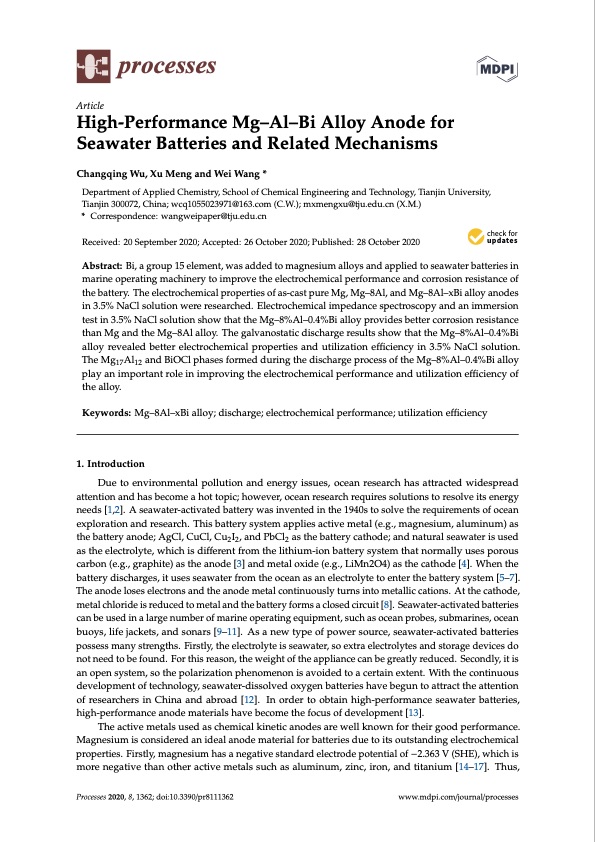
PDF Publication Title:
Text from PDF Page: 001
processes Article High-Performance Mg–Al–Bi Alloy Anode for Seawater Batteries and Related Mechanisms Changqing Wu, Xu Meng and Wei Wang * Department of Applied Chemistry, School of Chemical Engineering and Technology, Tianjin University, Tianjin 300072, China; wcq1055023971@163.com (C.W.); mxmengxu@tju.edu.cn (X.M.) * Correspondence: wangweipaper@tju.edu.cn Received: 20 September 2020; Accepted: 26 October 2020; Published: 28 October 2020 Abstract: Bi, a group 15 element, was added to magnesium alloys and applied to seawater batteries in marine operating machinery to improve the electrochemical performance and corrosion resistance of the battery. The electrochemical properties of as-cast pure Mg, Mg–8Al, and Mg–8Al–xBi alloy anodes in 3.5% NaCl solution were researched. Electrochemical impedance spectroscopy and an immersion test in 3.5% NaCl solution show that the Mg–8%Al–0.4%Bi alloy provides better corrosion resistance than Mg and the Mg–8Al alloy. The galvanostatic discharge results show that the Mg–8%Al–0.4%Bi alloy revealed better electrochemical properties and utilization efficiency in 3.5% NaCl solution. The Mg17Al12 and BiOCl phases formed during the discharge process of the Mg–8%Al–0.4%Bi alloy play an important role in improving the electrochemical performance and utilization efficiency of the alloy. Keywords: Mg–8Al–xBi alloy; discharge; electrochemical performance; utilization efficiency 1. Introduction Due to environmental pollution and energy issues, ocean research has attracted widespread attention and has become a hot topic; however, ocean research requires solutions to resolve its energy needs [1,2]. A seawater-activated battery was invented in the 1940s to solve the requirements of ocean exploration and research. This battery system applies active metal (e.g., magnesium, aluminum) as the battery anode; AgCl, CuCl, Cu2I2, and PbCl2 as the battery cathode; and natural seawater is used as the electrolyte, which is different from the lithium-ion battery system that normally uses porous carbon (e.g., graphite) as the anode [3] and metal oxide (e.g., LiMn2O4) as the cathode [4]. When the battery discharges, it uses seawater from the ocean as an electrolyte to enter the battery system [5–7]. The anode loses electrons and the anode metal continuously turns into metallic cations. At the cathode, metal chloride is reduced to metal and the battery forms a closed circuit [8]. Seawater-activated batteries can be used in a large number of marine operating equipment, such as ocean probes, submarines, ocean buoys, life jackets, and sonars [9–11]. As a new type of power source, seawater-activated batteries possess many strengths. Firstly, the electrolyte is seawater, so extra electrolytes and storage devices do not need to be found. For this reason, the weight of the appliance can be greatly reduced. Secondly, it is an open system, so the polarization phenomenon is avoided to a certain extent. With the continuous development of technology, seawater-dissolved oxygen batteries have begun to attract the attention of researchers in China and abroad [12]. In order to obtain high-performance seawater batteries, high-performance anode materials have become the focus of development [13]. The active metals used as chemical kinetic anodes are well known for their good performance. Magnesium is considered an ideal anode material for batteries due to its outstanding electrochemical properties. Firstly, magnesium has a negative standard electrode potential of −2.363 V (SHE), which is more negative than other active metals such as aluminum, zinc, iron, and titanium [14–17]. Thus, Processes 2020, 8, 1362; doi:10.3390/pr8111362 www.mdpi.com/journal/processesPDF Image | Alloy Anode for Seawater Batteries and Related Mechanisms

PDF Search Title:
Alloy Anode for Seawater Batteries and Related MechanismsOriginal File Name Searched:
processes-08-01362.pdfDIY PDF Search: Google It | Yahoo | Bing
Product and Development Focus for Salgenx
Redox Flow Battery Technology: With the advent of the new USA tax credits for producing and selling batteries ($35/kW) we are focussing on a simple flow battery using shipping containers as the modular electrolyte storage units with tax credits up to $140,000 per system. Our main focus is on the salt battery. This battery can be used for both thermal and electrical storage applications. We call it the Cogeneration Battery or Cogen Battery. One project is converting salt (brine) based water conditioners to simultaneously produce power. In addition, there are many opportunities to extract Lithium from brine (salt lakes, groundwater, and producer water).Salt water or brine are huge sources for lithium. Most of the worlds lithium is acquired from a brine source. It's even in seawater in a low concentration. Brine is also a byproduct of huge powerplants, which can now use that as an electrolyte and a huge flow battery (which allows storage at the source).We welcome any business and equipment inquiries, as well as licensing our flow battery manufacturing.| CONTACT TEL: 608-238-6001 Email: greg@salgenx.com | RSS | AMP |